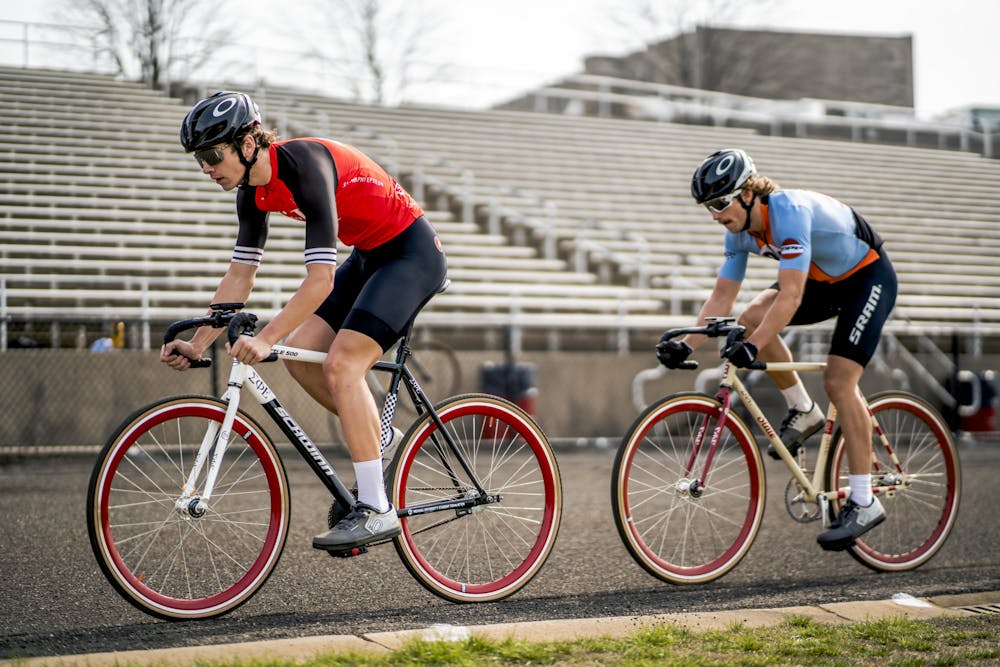Warm up your engines — or legs in this case — because “The World's Greatest College Weekend” is about to begin.
IU’s 72nd running of the Little 500 men’s race takes place Saturday.
The Little 500 is the largest collegiate bicycle race in the U.S. and attracts over 25,000 people every year to Bloomington, so for the newcomers and everyone interested in understanding its dimension, here’s the history of the men’s Little 500 race and how it became such a huge event.
In 1919, Howard Wilcox won the Indianapolis 500 — and a sweet prize of $20,000 — just a year before Howard “Howdy” Wilcox Jr. was born. In 1921, when Wilcox Jr. was just one year old, his mother died and, in 1924, Wilcox Sr. died in a car crash while racing in Altoona, Pennsylvania, leaving Wilcox Jr. as an orphan at just 3 years old.
Years later, Wilcox Jr. became the director of the IU Student Foundation and, while walking around campus in 1950, he saw IU students racing around campus with their bicycles. This prompted him to create the Little 500 and model it after the Indianapolis 500 as an homage to his father. Wilcox Jr. took the idea to the IU Student Foundation, arguing that the event would be a great way to raise funds for scholarships and bring the students and the university closer together.
In 1951, the first Little 500 took place. The South Hall Buccaneers finished first with a time of 02:38 hours, four seconds ahead of second place Sigma Alpha Epsilon, according to the IU Student Foundation website.
That first race raised $6,000 for scholarships and, since then, the Little 500 has helped raise over $2 million for students who work while in school.
Diversity through the years
Greek life was exclusively for white people since the late 1800’s in Bloomington, but that began to change in 1968. According to The Herald-Times, on the Friday ahead of the race that year, about 50 Black students barricaded themselves inside Bill Armstrong stadium, vowing to prevent the race from happening unless all involved fraternities got rid of many discriminatory clauses that prevented people of color from being a part of fraternities.
The IU president at the time, Elvis Stahr, encouraged all fraternities to comply with the students’ demands, and all but one house agreed. Phi Delta Theta refused to meet the demands and was dropped from the race as consequence. The race ended up being delayed by one day, due to both the protest and bad weather. Before 1968, people of color could only join the race if they created an independent team but, after the protest, representativity grew with greek houses including people of color to their houses and, consequently, teams.
In the 80’s, the Little 500’s inclusivity would grow even larger. In its early years, all-women teams tried and fail to qualify for the race, including Kappa Alpha Theta missing out by just one spot in 1987 with a time of 3:03.72.
Seeing the growing interest of women in the event, Kappa Alpha Delta worked tirelessly with the Dean of Women’s Affairs Phyllis Klotman and Assistant Director of the IU Student Foundation Spero Pulos to organize and promote an all-women's race.
The group recruited dormitories, sororities and independent riders and organized the first-ever event. In 1988, the first all-women race took place with 30 teams cycling 100 laps, half the men’s distance.
Kappa Alpha Theta finished second in the race, nine seconds behind Willkie Sprint, which recorded a time of 01:10.52.
Cutters and “Breaking Away”
Cutters was created in 1984 after the 1979 Academy Award-winning movie “Breaking Away.” The movie tells the story of a group of Bloomington teenagers who joined the Little 500 and called themselves the Cutters, after the stone cutting industry in Southern Indiana.
The real-life team won the Little 500 in its first season, and the win kickstarted the winningest team in the Little 500’s history. Cutters has won the race 14 times, with their most recent wins being back-to-back in 2018 and 2019.
The Cutters also hold the record for fastest Little 500 race, recording an outstanding 02:01.44 time in 1986.
After placing fourth in 2022, the Cutters hold first place this year with a time of 02:26.549 in the qualifying, a five-second difference from second place Sigma Phi Epsilon.
The women’s Little 500 race starts at 4 p.m. on Friday and the men’s starts at 2 p.m. on Saturday.




